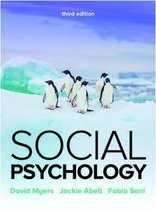,Week Topic Prep
Week 6 07.02.2023: Introduction Chapter 1 & 11
Article – Ostracism
09.02.2023: Small group Processes
Week 7 14.02.2023: The Self Chapter 3 & 4
Article – Egos inflating over time: A
16.02.2023: Social Beliefs and judgements cross-temporal meta-analysis of the
narcissistic personality inventory
Week 8 21.02/2023: Attitudes and Behaviour Chapter 5 & 6
Article – Attitude strength
23.02.2023: Persuasion
Week 9 28.02.2013: Conformity and Obedience Chapter 7 & 8
3 Articles !!
02.03.2023: Aggression
Week 10 07.03.2023: Attraction and Intimacy Chapter 9 & 14
Article - Human cooperation and
09.03.2023: Genes, Culture, and Gender the crises of climate
change, COVID-19, and
misinformation
Week 11 14.03.2023: Social categories and identity Chapter 12 & 13
Article - Gender Stereotypes
16.03.2023: Prejudice, intergroup Relations
and Conflict
Week 12 21.03.2023: Helping Chapter 10
Article - The bystander effect: A
meta-analytic review on
bystander intervention in
dangerous and non-dangerous
emergencies
,The Brain
Frontal lobe reasoning,
-
planning, movement, emotions, parts of speech, creativity, judgements, problem solving
Primary motor cortex -
voluntary control ofmovement
premotor area -
selection of movement based on external events
prefrontal personality and behavior;higher executive function:problem solving, initiation, moderation, and termination
area - of behavior
Motor speech (Broca's real expression of speech, responsible for construction of sentences/speech
area
-
Pre-supplementary motor area expression ofspeech, responsible for construction of sentences/speech
-
parietal lobe -
processing of nerve impulses related to senses, touch, pain, taste,
connected with pressure, temperature
Primary somatic sensory cortex receives sensory information from whole body
-
somatic sensory association area integrates sensory information based on sensory inputs
-
Taste area
Temporal lobe-hearing, memory, meaning, and language (also learning and emotion)
primary auditory cortex-volume, pitch, localization of basic sound
sensory speech area (Wernicke's area) recognition of spoken words;interpretation of meaning of speech with help of posterior language area
-
Occipital lobe vision, recognition ofobjects
-
Visual cortex-determines basic attributes of vision;light, shape, color, direction, depth (binocular vision)
Visual association area response to visual stimuliwithin receptive fields modulated by attention and working memory
-
-
Cerebellum -
primarily involved in coordination of movements/learning ofnew motor movements;helps smoothness daccuracy in movement;
converts motor signals into sequence of motor activation;has the ability to store and update motor information
a
Hindbrain
/
:
Central sulcus
Frontal lobe
Primary somatic
Primary motor
Cortex
Somatic sensory
I
Premotor
area
Parietal lobe
Prefrontal
n
dre
Sensory speech area
(Wernicke's area)
Motor speech area
Broca's area) Visual cortex
↳
⑲
Primary auditory occipital lobe
--
cortex
-
Visual
Lateral fissure
association area
Taste area
Temporal lobe Cerebellum
Hindbrain
, Introduction
Social psychology focuses determining scientificallyif abouthuman behavior true false.
proposition is
↳
on a or
levels ofAnalysis
Intrapersonal processes Intrapersonal relations Intra-group process Intergroup relations
↳
Within one
person
↳
one-on-one;dyads
↳i
within one
group
↳ between
groups
· -
- - - -
i -
= - -
: - -
Axioms of Social
Psychology
↳ basic
assumptions
1. "Human f(Person xSituation)
cognition, emotion, and behavior:
-
Role Personalityin
of behavior decreases as situational pressure increases
↳ differentsituations activate differentroles of
a
person
->
sometimes people choose the situation (navigat different roles/situations;extraverted people are more likelyto
attend a
party, while introverted people are less libel,
->
sometimes the situation chooses the person
(WillChamberlain-tall-basketball player
people change situations
->
↳ situations influence people
-
Contextdetermines how people perceive stimuli;often we don'trealize how much the situation influences us
i.e.:Titchener illusion
⑳ ·
Do ...
the middle circles
apper as differentsizes in context
8
->
Priming: situations create certain tendencies;pre-activate or make
knowledge more accessible
↳ The the Person
role of
Personality Psychology:focuses stable thatshape behavior;Extraversion;agreeableness...
-> on
psychological traits
-> social neuroscience:all
thoughts, emotions, and behavior are rooted in the physiological matter of
the brain;
everything we
experience is a chemical
process in the end
->
EvolutionaryPsychology:many psychological tendencies evolved because theyhelped ancestors our
survive
challenging environment heritabilityofbehavior;innatelyscared ofsnake
-
a
↳ The role of the situation
(we don'tknow
->
Marketing:influences the consumers;persuasion
choices of via
implicit why) or
explicit(we
why processes know
->
Group Psychology:crowds make people do things they otherwise wouldn't;conformity
->
Cultural
Psychology:how does culture shape our
feelings and behaviors
2. -
"People constructtheir own social reality- cultivated byprevious experiences
↳ Human
cognition, emotion, emotion, and behavior is
strongly influenced bythe interpretation/perception ofthe situation
people define situations
real, "if they their consequences" -perception
↳
Perception is as real, are real in
of
social much actual existance
supportmatters as as
When presented with
ambiguous stimuli,
↳
people "fill in the blanks" i.e. choose an interpretation
Consequences: Self-serving interpretations (perceiving yourself having done nothing when
argument)
=>
- as in
wrong,
an
Motivated
reasoning:selectivelyinterpreting evidence thatsupports their world view and
ignore
evidence
-
againstit -
subjective beliefs as
objective truths
Ideological difficult to compromise when differentparties experience their moral world
conflict: very view
-
as an objective truths;staystubborn on their point





